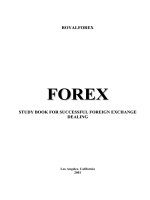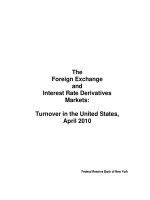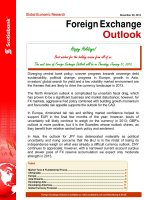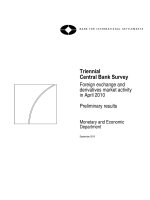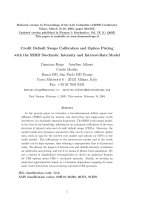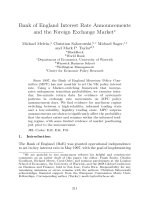Foreign exchange option pricing
Bạn đang xem bản rút gọn của tài liệu. Xem và tải ngay bản đầy đủ của tài liệu tại đây (23.37 MB, 300 trang )
P1: JYS
JWBK492-FM
JWBK492-Clark
October 13, 2010
4:5
Printer: Yet to come
iii
P1: JYS
JWBK492-FM
JWBK492-Clark
October 13, 2010
4:5
Printer: Yet to come
Foreign Exchange Option Pricing
i
P1: JYS
JWBK492-FM
JWBK492-Clark
October 13, 2010
4:5
Printer: Yet to come
For other titles in the Wiley Finance series
please see www.wiley.com/finance
ii
P1: JYS
JWBK492-FM
JWBK492-Clark
October 13, 2010
4:5
Printer: Yet to come
Foreign Exchange Option Pricing
A Practitioner’s Guide
Iain J. Clark
A John Wiley and Sons, Ltd., Publication
iii
P1: JYS
JWBK492-FM
JWBK492-Clark
October 13, 2010
4:5
Printer: Yet to come
This edition first published 2011
C 2011 Iain J. Clark
Registered office
John Wiley & Sons Ltd, The Atrium, Southern Gate, Chichester, West Sussex, PO19 8SQ, United Kingdom
For details of our global editorial offices, for customer services and for information about how to apply for
permission to reuse the copyright material in this book please see our website at www.wiley.com.
The right of the author to be identified as the author of this work has been asserted in accordance with the
Copyright, Designs and Patents Act 1988.
All rights reserved. No part of this publication may be reproduced, stored in a retrieval system, or transmitted, in
any form or by any means, electronic, mechanical, photocopying, recording or otherwise, except as permitted by the
UK Copyright, Designs and Patents Act 1988, without the prior permission of the publisher.
Wiley also publishes its books in a variety of electronic formats. Some content that appears in print may not be
available in electronic books.
Designations used by companies to distinguish their products are often claimed as trademarks. All brand names and
product names used in this book are trade names, service marks, trademarks or registered trademarks of their
respective owners. The publisher is not associated with any product or vendor mentioned in this book. This
publication is designed to provide accurate and authoritative information in regard to the subject matter covered. It
is sold on the understanding that the publisher is not engaged in rendering professional services. If professional
advice or other expert assistance is required, the services of a competent professional should be sought.
Library of Congress Cataloging-in-Publication Data
Clark, Iain J.
Foreign exchange option pricing : a practitioner’s guide / Iain J. Clark.
p. cm.
ISBN 978-0-470-68368-2
1. Options (Finance)–Prices. 2. Stock options. 3. Foreign exchange rates. I. Title.
HG6024.A3C563 2011
332.4 5–dc22
2010030438
A catalogue record for this book is available from the British Library.
ISBN 978-0-470-68368-2
Typeset in 10/12pt Times by Aptara Inc., New Delhi, India
Printed in Great Britain by Antony Rowe Ltd, Chippenham, Wiltshire
iv
P1: JYS
JWBK492-FM
JWBK492-Clark
October 13, 2010
4:5
Printer: Yet to come
For Isabel
v
P1: JYS
JWBK492-FM
JWBK492-Clark
October 13, 2010
4:5
Printer: Yet to come
vi
P1: JYS
JWBK492-FM
JWBK492-Clark
October 13, 2010
4:5
Printer: Yet to come
Contents
Acknowledgements
xiii
List of Tables
xv
List of Figures
xvii
1 Introduction
1.1 A Gentle Introduction to FX Markets
1.2 Quotation Styles
1.3 Risk Considerations
1.4 Spot Settlement Rules
1.5 Expiry and Delivery Rules
1.5.1 Expiry and delivery rules – days or weeks
1.5.2 Expiry and delivery rules – months or years
1.6 Cutoff Times
1
1
2
5
5
8
8
9
10
2 Mathematical Preliminaries
2.1 The Black–Scholes Model
2.1.1 Assumptions of the Black–Scholes model
2.2 Risk Neutrality
2.3 Derivation of the Black–Scholes equation
2.3.1 Equity derivatives (without dividends)
2.3.2 FX derivatives
2.3.3 Terminal conditions and present value
2.4 Integrating the SDE for ST
2.5 Black–Scholes PDEs Expressed in Logspot
2.6 Feynman–Kac and Risk-Neutral Expectation
2.7 Risk Neutrality and the Presumption of Drift
2.7.1 Equity derivatives (without dividends)
2.7.2 FX derivatives – domestic risk-neutral measure
2.7.3 FX derivatives – foreign risk-neutral measure
2.8 Valuation of European Options
2.8.1 Forward
13
13
13
13
14
14
15
17
17
18
18
20
20
21
22
23
26
vii
P1: JYS
JWBK492-FM
JWBK492-Clark
viii
October 13, 2010
4:5
Printer: Yet to come
Contents
2.9
2.10
2.11
2.12
2.13
2.14
2.15
2.16
The Law of One Price
The Black–Scholes Term Structure Model
Breeden–Litzenberger Analysis
European Digitals
2.12.1 Static replication for bid/offer digital pricing
Settlement Adjustments
Delayed Delivery Adjustments
2.14.1 Delayed delivery adjustments – digitals
2.14.2 Delayed delivery adjustments – Europeans
Pricing using Fourier Methods
2.15.1 European option pricing involving one numerical integral
Leptokurtosis – More than Fat Tails
3 Deltas and Market Conventions
3.1 Quote Style Conversions
3.2 The Law of Many Deltas
3.2.1 Pips spot delta
3.2.2 Percentage spot delta (premium adjusted)
3.2.3 Pips forward delta
3.2.4 Percentage forward delta (premium adjusted)
3.2.5 Simple delta
3.2.6 Equivalence between pips and percentage deltas
3.2.7 Premium adjustment
3.2.8 Summary
3.3 FX Delta Conventions
3.3.1 To premium adjust or not?
3.3.2 Spot delta or forward delta?
3.3.3 Notation
3.4 Market Volatility Surfaces
3.4.1 Sample market volatility surfaces
3.5 At-the-Money
3.5.1 At-the-money – ATMF
3.5.2 At-the-money – DNS
3.5.3 At-the-money strikes – summary
3.5.4 Example – EURUSD 1Y
3.5.5 Example – USDJPY 1Y
3.6 Market Strangle
3.6.1 Example – EURUSD 1Y
3.7 Smile Strangle and Risk Reversal
3.7.1 Smile strangle from market strangle – algorithm
3.8 Visualisation of Strangles
3.9 Smile Interpolation – Polynomial in Delta
3.9.1 Example – EURUSD 1Y – polynomial in delta
3.10 Smile Interpolation – SABR
3.10.1 Example – EURUSD 1Y – SABR
3.11 Concluding Remarks
27
28
30
31
32
32
33
33
34
35
37
38
41
41
43
44
45
45
45
45
46
46
47
47
47
48
49
49
50
50
51
51
52
52
53
53
55
55
56
57
59
59
60
61
62
P1: JYS
JWBK492-FM
JWBK492-Clark
October 13, 2010
4:5
Printer: Yet to come
Contents
ix
4 Volatility Surface Construction
4.1 Volatility Backbone – Flat Forward Interpolation
4.2 Volatility Surface Temporal Interpolation
4.2.1 Volatility smile extrapolation
4.2.2 Volatility smile interpolation
4.2.3 Flat forward vol interpolation in smile strikes
4.2.4 Example – EURUSD 18M from 1Y and 2Y tenors – SABR
4.3 Volatility Surface Temporal Interpolation – Holidays and Weekends
4.4 Volatility Surface Temporal Interpolation – Intraday Effects
63
65
67
67
68
69
70
70
73
5 Local Volatility and Implied Volatility
5.1 Introduction
5.2 The Fokker–Planck Equation
5.2.1 Derivation of the one-dimensional Fokker–Planck equation
5.2.2 The multidimensional Fokker–Planck equation
5.3 Dupire’s Construction of Local Volatility
5.3.1 Dupire’s local volatility – the r d = r f = 0 case
5.3.2 Dupire’s local volatility – with nonzero but constant interest
rates
5.4 Implied Volatility and Relationship to Local Volatility
5.5 Local Volatility as Conditional Expectation
5.6 Local Volatility for FX Markets
5.7 Diffusion and PDE for Local Volatility
5.8 The CEV Model
5.8.1 Asymptotic expansion
77
77
78
79
82
83
84
6 Stochastic Volatility
6.1 Introduction
6.2 Uncertain Volatility
6.3 Stochastic Volatility Models
6.3.1 The Heston model
6.3.2 The Stein and Stein model
6.3.3 Longstaff’s double square root model
6.3.4 Scott’s exponential Ornstein–Uhlenbeck model
6.3.5 The SABR model
6.4 Uncorrelated Stochastic Volatility
6.5 Stochastic Volatility Correlated with Spot
6.6 The Fokker–Planck PDE Approach
6.7 The Feynman–Kac PDE Approach
6.7.1 Heston model – example
6.7.2 Heston model – logspot coordinates
6.8 Local Stochastic Volatility (LSV) Models
6.8.1 Calibration of local volatility in LSV models
6.8.2 Fokker–Planck equation for the LSV model
6.8.3 Forward induction for local volatility calibration on LSV
6.8.4 Calibrating stochastic and local volatilities
6.8.5 The pricing PDE for LSV models
85
86
87
88
89
90
91
95
95
95
96
98
104
105
105
106
107
108
111
113
116
117
117
118
119
120
124
127
P1: JYS
JWBK492-FM
JWBK492-Clark
x
October 13, 2010
4:5
Printer: Yet to come
Contents
7 Numerical Methods for Pricing and Calibration
7.1 One-Dimensional Root Finding – Implied Volatility Calculation
7.2 Nonlinear Least Squares Minimisation
7.3 Monte Carlo Simulation
7.3.1 Handling large timesteps with local volatility
√
7.3.2 Monte Carlo convergence goes as 1/ N
7.3.3 Finding a balance between simulations and timesteps
7.3.4 Quasi Monte Carlo convergence can be as good as 1/N
7.3.5 Variance reduction
7.4 Convection–Diffusion PDEs in Finance
7.4.1 Visualising diffusion
7.4.2 Visualising convection
7.5 Numerical Methods for PDEs
7.6 Explicit Finite Difference Scheme
7.6.1 Boundary conditions
7.6.2 Von Neumann stability and the dimensionless heat equation
7.7 Explicit Finite Difference on Nonuniform Meshes
7.7.1 Mixed partial derivative terms on nonuniform meshes
7.8 Implicit Finite Difference Scheme
7.9 The Crank–Nicolson Scheme
7.10 Numerical Schemes for Multidimensional PDEs
7.10.1 Two-dimensional Crank–Nicolson scheme
7.10.2 An early ADI scheme – Peaceman–Rachford splitting
7.10.3 Douglas–Rachford splitting
7.10.4 Craig–Sneyd splitting
7.11 Practical Nonuniform Grid Generation Schemes
7.11.1 Uniform grid generation
7.11.2 Uniform grid generation with required levels
7.11.3 Spatial grid generation
7.11.4 Temporal grid generation
7.12 Further Reading
129
129
130
131
134
135
138
142
143
147
149
151
153
155
157
159
163
165
165
167
168
169
169
171
172
173
173
173
174
175
176
8 First Generation Exotics – Binary and Barrier Options
8.1 The Reflection Principle
8.2 European Barriers and Binaries
8.2.1 European barriers
8.2.2 Barrier parity relationships
8.2.3 European digitals
8.3 Continuously Monitored Binaries and Barriers
8.3.1 Domestic binaries
8.3.2 Foreign binaries
8.3.3 Instant one-touch products
8.3.4 Barrier products
8.3.5 KIKOs and ONTOs
8.4 Double Barrier Products
8.5 Sensitivity to Local and Stochastic Volatility
8.6 Barrier Bending
177
179
180
180
182
183
183
188
189
190
191
194
194
195
197
P1: JYS
JWBK492-FM
JWBK492-Clark
October 13, 2010
4:5
Printer: Yet to come
Contents
8.7
Value Monitoring
8.7.1 Compounds
8.7.2 Americans
8.7.3 Bermudans
9 Second Generation Exotics
9.1 Chooser Options
9.2 Range Accrual Options
9.3 Forward Start Options
9.3.1 Strike reset options
9.4 Lookback Options
9.4.1 Double lookback options
9.5 Asian Options
9.5.1 Notes on seasoned Asians and fixing at expiry
9.6 Target Redemption Notes
9.7 Volatility and Variance Swaps
9.7.1 Volatility observation
9.7.2 Product specification and value at expiry
9.7.3 Variance swap product valuation
9.7.4 Volatility swap product valuation
xi
202
202
203
203
205
206
206
207
209
209
211
212
214
214
214
215
216
217
219
10 Multicurrency Options
10.1 Correlations, Triangulation and Absence of Arbitrage
10.2 Exchange Options
10.3 Quantos
10.3.1 Self-quanto option
10.3.2 Self-quanto forward
10.3.3 General quanto options
10.4 Best-ofs and Worst-ofs
10.4.1 Two-asset best-of call
10.4.2 Three-asset best-of call
10.4.3 N -asset best-of call
10.5 Basket Options
10.6 Numerical Methods
10.7 A Note on Multicurrency Greeks
10.8 Quantoing Untradeable Factors
10.9 Further Reading
225
226
229
229
230
231
231
233
234
236
239
239
241
242
243
244
11 Longdated FX
11.1 Currency Swaps
11.2 Basis Risk
11.3 Forward Measure
11.4 LIBOR in Arrears
11.5 Typical Longdated FX Products
11.5.1 Power reverse dual currency notes
11.5.2 FX target redemption notes
11.5.3 Effect on USDJPY volatility smile
245
245
247
249
250
253
253
254
255
P1: JYS
JWBK492-FM
JWBK492-Clark
xii
October 13, 2010
4:5
Printer: Yet to come
Contents
11.6 The Three-Factor Model
11.7 Interest Rate Calibration of the Three-Factor Model
11.7.1 Determination of drifts
11.7.2 Determination of Hull–White volatilities
11.8 Spot FX Calibration of the Three-Factor Model
11.8.1 FX vanillas with lognormal spot FX
11.8.2 FX vanillas with CEV local volatility
11.8.3 FX vanillas with Dupire local volatility
11.9 Conclusion
255
257
257
258
259
260
261
262
264
References
265
Further Reading
271
Index
273
P1: JYS
JWBK492-FM
JWBK492-Clark
October 13, 2010
4:5
Printer: Yet to come
Acknowledgements
I would like to thank everyone at Standard Bank, particularly Peter Glancey and Marcelo
Labre, for their patience during the execution of this work. This is an industry book and it
would not have happened without the help and encouragement of everyone I’ve worked with,
most recently at Standard Bank and in previous years at JP Morgan, BNP Paribas, Lehman
Brothers, Dresdner Kleinwort and Commerzbank. As such, special thanks are due to David
Kitson, J´erˆome Lebuchoux, Marek Musiela, Nicolas Jackson, Robert Campbell, Dominic
O’Kane, Ronan Dowling, Tim Sharp, Ian Robertson, Alex Langnau and John Juer.
A special debt of gratitude to Messaoud Chibane, outstanding quant and very good friend,
who has encouraged me every step of the way over the years.
For parts of Chapter 11, I am indebted to the excellent work on longdated modelling of my
former team members at Dresdner Kleinwort: Andrey Gal, Chia Tan, Olivier Taghi and Lars
Schouw.
I must also thank Pete Baker, Aimee Dibbens, Karen Weller and Lori Boulton at Wiley
Finance for their help and patience with me during the completion and production of this
work, as well as all the rest of the Wiley team who have done such an excellent job to bring
this book to publication. While I take sole responsibility for any errors that remain in this
work, I am very grateful to Pat Bateson and Rachael Wilkie for their thoroughness in checking
the manuscript. Thanks are due to my literary agent Isabel White for seeing the potential for
me to write a book on this topic.
I would also like to thank my amazing wife, to whom I owe more than I can possibly say.
I am as always grateful to my parents John and Joan for their love, support and tolerance of
my difficult questions and interest in science and mathematics – I’m glad to say some things
haven’t changed so much! Also to my extended family, whom I don’t get to see as often as I
would like, thanks for keeping us in your thoughts and all your messages of encouragement.
They mean a lot to an author.
Finally, to my young nieces and nephews in Canada – Andrew, Bradley, Isabel, Mackenzie
and William – who asked me if my mathematics book for grown-ups was going to have ‘very
hard sums’ like 1 000 010 −1 000 000 012, I have a very hard sum just for you:
101 598 490
+ 21 858 299
xiii
P1: JYS
JWBK492-FM
JWBK492-Clark
xiv
October 13, 2010
4:5
Printer: Yet to come
Acknowledgements
This book is for you and for all students, young and old, of the mathematical arts. I wish
you all the very best with your studies and your work.
Web page for this book
www.fxoptionpricing.com
P1: JYS
JWBK492-FM
JWBK492-Clark
October 13, 2010
4:5
Printer: Yet to come
List of Tables
1.1
1.2
1.3
2.1
3.1
3.2
3.3
3.4
3.5
3.6
3.7
3.8
4.1
4.2
4.3
4.4
4.5
4.6
4.7
4.8
5.1
5.2
5.3
5.4
5.5
6.1
6.2
6.3
6.4
6.5
7.1
7.2
Currency pair quotation conventions and market terminology
Currency pair exceptions to T+2 settlement
Cutoff times
European digitals
Delta conventions for common currency pairs
Premium currency for major currency pairs
Sample market volatility surface for EURUSD
Sample market volatility surface for USDJPY
1Y EURUSD smile with polynomial delta parameterisation
1Y EURUSD Black–Scholes prices under delta polynomial
1Y EURUSD smile with SABR parameterisation
1Y EURUSD Black–Scholes prices under SABR
Flat forward volatility interpolation by smile strike
EURUSD market strangle and risk reversal at 1Y and 2Y
EURUSD smile at 1Y and 2Y
EURUSD smile at 1Y and 2Y with consistent market conventions
Interpolated 18M EURUSD smile
Typical term structure of volatility on a Friday
Sample shortdated EURUSD day weights
Sample intraday EURUSD weights
A trivial upward sloping two-period term structure of implied volatility
Forward volatility consistent with upward sloping implied volatility
Implied and forward volatilities for a typical ATM volatility structure
Example of implied volatility surface with convexity only beyond 1Y
Example of local volatility surface with convexity only beyond 1Y
Common stochastic volatility models in the literature
Parameters of the Heston model
Violation of Heston Feller condition in typical FX markets
Parameters of the Stein and Stein model
Violation of Heston Feller condition even after 65% mixing weight
Standard errors halved by quadrupling
Nsims
√
Standard error multiplied by 100 Nsims
xv
3
6
11
31
48
48
50
50
59
60
61
61
69
70
70
71
71
72
73
74
78
78
79
79
80
98
98
99
104
126
137
137
P1: JYS
JWBK492-FM
JWBK492-Clark
xvi
October 13, 2010
4:5
Printer: Yet to come
List of Tables
√
7.3 European call: standard error multiplied by 100 000 NCPU for increasing
Nsims
√
7.4 European call: standard error multiplied by 100 000 NCPU for increasing
Nsims and Ntimes
7.5 Importance sampling example
8.1 American digitals/binaries
8.2 Barrier options
10.1 Arbitrage trade for inconsistent currency triangle
11.1 Typical basis swap spreads as of September 2007 (Source: Lehman Brothers)
138
138
144
178
181
226
249
P1: JYS
JWBK492-FM
JWBK492-Clark
October 13, 2010
4:5
Printer: Yet to come
List of Figures
1.1
2.1
2.2
2.3
2.4
2.5
3.1
3.2
3.3
3.4
3.5
3.6
4.1
4.2
4.3
4.4
5.1
6.1
6.2
6.3
6.4
6.5
6.6
6.7
Dates of importance for FX trading
Payout function VT for European call
Payout function VT for European put
Payout function VT for European forward
Sample leptokurtic density functions: (a) leptokurtic density functions – largescale view; (b) leptokurtic density functions – tail region
Leptokurtic likelihood ratio: PearsonVII(1000) relative to N (0, 1)
Vd; pips value profile for delta-neutral straddle (T = 1.0, K = 1.3620)
Vd; pips value profile for 25-delta market strangle (call component)
(T = 1.0, K = 1.5449)
Vd; pips value profile for 25-delta market strangle (put component)
(T = 1.0, K = 1.2050)
Schematic illustration of the smile strangle
Schematic illustration of the market strangle
Highly skewed smile (1Y USDJPY)
Volatility surface for EURUSD. c 2010 Bloomberg Finance L.P. All rights
reserved. Used with permission
Volatility surface for USDJPY. c 2010 Bloomberg Finance L.P. All rights
reserved. Used with permission
Upper and lower bounds for interpolated volatility term structure
Intraday forward volatility mask for EURUSD
Sample local volatility
Increasing dispersion of a driftless variance process reduces σATM
Initial probability distribution for the forward Fokker–Planck equation
Interim probability distribution from the forward Fokker–Planck equation
Bootstrapped local volatility contribution A(X, t) for EURUSD as of
December 2008
Bootstrapped local volatility contribution A(X, t) for USDJPY as of
December 2008
Bootstrapped local volatility contribution A(X, t) for USDJPY as of
December 2008 with ρ ≈ 0
Mesh for two-dimensional Fokker–Planck equation: (a) schematic mesh;
(b) realistic mesh (50 × 50)
xvii
2
23
26
26
39
40
53
54
54
57
58
58
64
64
66
74
81
97
121
121
122
122
123
125
P1: JYS
JWBK492-FM
JWBK492-Clark
xviii
October 13, 2010
4:5
Printer: Yet to come
List of Figures
7.1 European call, Ntimes = 10: PV estimate and ±1 s.d. error bars
7.2 European call, Ntimes = 1: PV estimate and ±1 s.d. error bars
7.3 Double no-touch : PV estimate and ±1 s.d. error bars: (a) Ntimes = 10;
(b) Ntimes = 30; (c) Ntimes = 60
7.4 Monte Carlo in Pd and P f : PV estimate and ±1 s.d. error bars (a) Monte
Carlo simulation in Pd ; (b) Monte Carlo simulation in P f
7.5 Schematic illustrations of one- and two-dimensional convection diffusion
PDEs: (a) Black–Scholes diffusion; (b) local volatility diffusion; (c) stochastic
volatility diffusion; (d) local stochastic volatility diffusion
7.6 Heston convection
7.7 Three-factor convection
7.8 Cross-sectional representation of convection for the three-factor FX/IR model
(a) x component of convection for the three-factor FX/IR model as a function
of (y, z); (b) cross-sectional representation of convection for the three-factor
FX/IR model
7.9 Explicit finite difference stencil
7.10 Calculation of spatial derivatives using fitted parabola
7.11 Implicit finite difference stencil
7.12 Crank–Nicolson finite difference stencil
7.13 Peaceman–Rachford finite difference stencil
8.1 Digitals
8.2 The reflection principle
8.3 Payout function VT for European up-and-out call
8.4 Payout function VT for European down-and-out put
8.5 Measure change for application of the reflection principle
8.6 The moustache graph
8.7 The model implied moustache graph
8.8 The model implied DNT profile
8.9 Value and delta profile for RKO call: (a) value profile; (b) delta profile;
(c) delta heatmap
8.10 Value profile for tight RKO call spread
8.11 Value and delta profile for RKO call with U = 1.1035: (a) value profile;
(b) delta heatmap
8.12 Delta heatmap for RKO call with barrier bend from U = 1.10 to U = 1.1035
10.1 Currency triangles: (a) simple initial triangle; (b) currency triangle after
appreciation of USD against both EUR and JPY (EURJPY unchanged;
(c) currency triangle after appreciation of EUR against both USD and JPY
(USDJPY unchanged)
10.2 Currency tetrahedron
11.1 Vega and rho profiles for ATMF options
11.2 Cross-currency swaps: (a) fixed–fixed cross-currency swap; (b) floating–
floating cross-currency swap
11.3 LIBOR floating cashflow diagrams: (a) standard LIBOR coupon; (b) LIBOR
in arrears coupon
136
139
140
145
150
152
153
154
156
164
166
168
170
178
179
180
181
186
196
197
197
198
199
201
202
227
229
246
247
250
P1: OTE/OTE/SPH
P2: OTE
JWBK492-FUR
JWBK492-Clark
October 5, 2010
13:16
Printer: Yet to come
Further Reading
Albrecher, H., Mayer, P., Schoutens, W. and Tistaert, J. (2006) The Little Heston Trap (Version: 11
September 2006). />1/HestonTrap.pdf
Ball, C. A. and Roma, A. (1994) Stochastic volatility option pricing. Journal of Financial and Quantitative
Analysis, 29: 581–607.
Bloch, D. and Nakashima, Y. (2008) Multi-Currency Local Volatility Model. Mizuho Securities Working
Paper (Version: August 2008). />Borodin, A. N. and Salminen, P. (1996) Handbook of Brownian Motion – Facts and Formulae. Birkh¨auser,
Basel.
Breeden, D. T. and Litzenberger, R. H. (1978) Prices of State-Contingent Claims Implicit in Option
Prices. The Journal of Business, 51(4): 621–651.
Briys, E., Bellalah, M. Mai, H. M. and de Varenne, F. (1998) Options, Futures and Exotic Derivatives:
Theory, Application and Practice. John Wiley & Sons, Ltd, Chichester.
Burch, D. (2007) Girsanov’s Theorem and Importance Sampling. />tkemp/18.177/Girsanov.Sampling.pdf
Carr, P. and Madan, D. B. (2005) A Note on Sufficient Conditions for No Arbitrage. Finance Research
Letters, 2: 125–130.
Chibane, M. (2010) Modeling Long Dated Hybrid Structures, presented at ICBI Global Derivatives
conference, Paris, 19 May 2010.
Christoffersen, P. and Mazzotta, S. (2004) The Informational Content of Over-The-Counter
Currency Options, ECB Working Paper 366. />scpwps/ecbwp366.pdf
Eckhardt, R. (1987) Stan Ulam, John von Neumann, and the Monte Carlo Method. Los Alamos Science,
Special Issue (15): 131–137.
Elices, A. and Fouque, J.P. (2010) Perturbed Copula: Introducing the skew effect in the co-dependence.
(Version: 27 February 2010). />Fouque, J. P., Papanicolaou, G. and Sircar, K. R. (2001) Derivatives in Financial Markets with Stochastic
Volatility. Cambridge University Press, Cambridge.
Giles, M. and Carter, R. (2006) Convergence Analysis of Crank–Nicolson and Rannacher TimeMarching. Computational Finance, 9(4): 89–112.
Glasserman, P., Heidelberger, P. and Shahabuddin, P. (1999) Asymptotically Optimal Importance Sampling and Stratification for Pricing Path-Dependent Options. Mathematical Finance, 9(2): 117–162.
Guasoni, P. and Robertson, S. (2008) Optimal Importance Sampling with Explicit Formulas in
Continuous Time. Finance and Stochastics, 12(1): 1–19. />guasoni/papers/isbs.pdf
Kac, M. (1949) On Distributions of Certain Wiener Functionals. Transactions of the American Mathematical Society, 65(1): 1–13.
Kahl, C. and J¨ackel, P. (2005) Not-so-Complex Logarithms in the Heston Model. Wilmott Magazine:
94–103.
271
P1: OTE/OTE/SPH
P2: OTE
JWBK492-FUR
JWBK492-Clark
272
October 5, 2010
13:16
Printer: Yet to come
Further Reading
Kloeden, P. E., Platen, E. and Schurz, H. (1997) Numerical Solution of SDE Through Computer Experiments. Springer, Berlin.
Kwok, Y.-K. (1998) Mathematical Models of Financial Derivatives. Springer, Singapore.
Kwok, Y.-K. (2009) Lattice Tree Methods for Strongly Path Dependent Options. />abstract=1421736
Lamberton, B. and Lapeyre, B. (1996) Introduction to Stochastic Calculus Applied to Finance, trans. N.
Rabeau and F. Mantion. Chapman and Hall, London.
Lin, J. and Ritchken, P. (2006) On Pricing Derivatives in the Presence of Auxiliary State Variables.
Journal of Derivatives, 14(2): 29–46.
McKee, S., Wall, D. P. and Wilson, S. K. (1996) An Alternating Direction Implicit Scheme for Parabolic
Equations with Mixed Derivative and Convective Terms. Journal of Computational Physics, 126(2):
64–76.
Majmin, L. (2005) Local and Stochastic Volatility Models: An Investigation into the Pricing of Exotic
Equity Options. MSc Dissertation, University of the Witwatersrand.
Mikhailov, S. and N¨ogel, U. (2003) Heston’s Stochastic Volatility Model, Calibration and Some Extensions. Wilmott Magazine: 74–79.
Pelsser, A. (2001) Mathematical Foundation of Convexity Correction (Version: 18 April 2001).
/>Piterbarg, V. (2005b) Time to Smile. Wilmott Magazine, (May): 71–75.
Reiswich, D. and Wystup, U. (2009) FX Volatility Smile Construction (Version: 8 September 2009).
Arbeits20.pdf
Rebonato, R. (2004) Volatility and Correlation, 2nd edition. John Wiley & Sons, Ltd, Chichester.
Salmon, M. and Schleicher, C. (2006) Pricing Multivariate Currency Options with Copulas. University of Warwick Financial Econometrics Research Centre Working Paper WP06-21. http://
www2.warwick.ac.uk/fac/soc/wbs/research/wfri/rsrchcentres/ferc/
wrkingpaprseries/fwp06-21.pdf
Sheppard, R. (2007) Pricing Equity Derivatives under Stochastic Volatility: A Partial Differential Equation Approach. MSc Dissertation, University of the Witwatersrand.
Weithers, T. (2006) Foreign Exchange: A Practical Guide to the FX Markets. John Wiley & Sons, Ltd,
Chichester.
P1: OTE
ind
JWBK492-Clark
October 14, 2010
16:56
Printer: Yet to come
Index
Bessel process 100, 136
best-ofs 233–9
bid/offer digital pricing, static replication
methods 32
bid/offer spreads 1, 196–7
bilinear or bicubic interpolation uses 63
binary options 31–2, 138–42, 178, 183–203
see also digitals
binomial models 95–7, 107
see also finite difference methods
bisection method 129–30
Black (1976) model 27
Black–Scholes equation, concepts 14–20, 42–3,
77, 88–9, 264
Black–Scholes model 13–40, 41–7, 53–5, 63, 77,
81–3, 86–9, 95–7, 107–8, 113, 129–38,
144–53, 180–2, 193–7, 208–9, 211, 219–24,
226–7, 230–3, 239–41, 245–6, 259, 264
assumptions 13–14, 41, 53–5, 77, 88, 95–6
critique 27, 28, 41, 77, 195–6
law of one price 27–8, 43, 229
numerical methods 129–53
Black–Scholes term structure model 28–9, 41,
77, 95–7, 148–53, 219–24
see also term-structure prices
Bloomberg Finance L.P. 63–4
bonds 15–17, 20–3, 33, 245–51, 257–8
boundary conditions 157–73
Box–Muller method 133
Breeden-Litzenberger analysis 30–1, 77, 83
Brent scheme 129–30
British Summer Time (BST) 11
BRL 3, 4, 7, 48–9, 51, 99, 126
Broadie–Glassermann–Kou correction 139–42
broken dated options 63
Brownian bridge Monte Carlo approach 141–3
Brownian motion 13, 17–18, 20–3, 72, 82–3,
87–8, 96–7, 104–5, 107–11, 132–5, 141–3,
179–80, 184–7, 228–9, 240–1, 255–9,
260–4
butterflies 130–1
ADI schemes 120–1, 169–71, 176
see also Craig–Sneyd. . . ;
Peaceman–Rachford. . .
aggregate prices, volatility smiles 54–61
American digitals/binaries 178–9, 183–4,
187–8
see also binary options; digitals
American options 178–9, 183–4, 187–8, 202–3,
254
antithetic sampling, concepts 143–7
ARS 6–7
Asian options 144, 205, 212–14, 242
asset classes 1, 131–2
asset-or-nothing digitals 185–6, 191–5
asymptotic expansion 91–3, 111
at-the-money options (ATM) 47, 49–55, 57–61,
63–4, 67–75, 79–93, 95–7, 99–104, 136–8,
245–6
AUD 2–3, 4, 7, 48–9, 99, 107, 126, 228–9,
248–9, 253, 255
auxiliary state variables 205–24, 242, 264
average strike calls/puts 213
average-rate options see Asian options
backward Kolmogorov equations 18–20
backward PDE schemes 14–20, 103–4, 113,
149–53, 175–6
backward tau and central space method (BTCS)
163, 165–8
barrier bending 173, 197–202, 264
barrier options 138–42, 147, 157–8, 168, 176,
177–203, 205–7, 209, 242–3, 264
continuous monitoring 183–95, 209, 264
definitions 177–8, 180–3
types 180–2, 191–6
basis risk 246–9
basis swaps 247–9
basket options 142–3, 148–9, 225–6, 239–41
benchmark tenors, liquid markets 63–5, 67–75,
99–100
Bermudan options 133–4, 203, 254
273
P1: OTE
ind
JWBK492-Clark
274
October 14, 2010
16:56
Printer: Yet to come
Index
CAD 2–3, 4–6, 7, 48–9, 248–9
calibration 68–9, 103–4, 111, 118–28, 129–76,
257–64
‘Call Option Solution II’ 38
call options 23–8, 30–2, 34–8, 42–3, 49–50,
53–4, 60–1, 72–5, 77–93, 136–8, 177–203,
206–24, 233–44
callable PRDCs 254
caplets 257
cash-or-nothing digitals 178, 185–6, 191–5
CEV model 90–3, 261–2
chain rule 19–20
CHF 3, 4, 48–9, 100, 124, 127
Cholesky decomposition 109–11, 228–9, 242,
243–4, 256
chooser options 206, 254
CIR model 98, 100, 102
CLP 6–7
collapse condition 206–24
compound options 202–3
conditional expectations, local volatilities 87–8
continuous monitoring 183–95, 209, 264
continuous time using discrete approximations
(CTDA) 75
control variate technique 143–7
convection–diffusion PDEs in finance 147–53,
161–5, 169–71, 206–24, 244
convergence 35–8, 135–8, 142–3, 146–7
convexity 79–81, 96, 122–7, 253, 257–64
correlations 60–1, 98–104, 107–8, 176, 225–44
covariance 234–5
Craig–Sneyd splitting schemes 172–3, 176
Crank–Nicolson implicit scheme 163, 167–8,
169–71
credit crunch from 2008 48–9, 122–3
cumulative distribution function (CDF) 25–8,
67–8, 133–4, 234–9
currency swaps 245–9
cutoff times 10–11
CZK 48
day count conventions 33
daylight saving time (DST) 7, 10–11
days, good business days 6–7, 70–5
days/weeks/months/years rules, expiry/delivery
rules 8–10
decision rules, Monte Carlo simulations 137–8
decomposition pricing principle 191
delay adjustments, delivery dates 33–5
delivery dates 1–2, 8–11, 32–5
delta hedging 15, 113–17
see also dynamic. . .
delta-neutral straddles (DNS) 50–3, 68
deltas 15, 41–62, 68–75, 88–9, 113–17,
197–202, 242
see also gammas; spot. . . ; volatility smiles
barrier bending 197–202
heatmaps 198–202
law of many deltas 43–7, 62
market conventions 41, 47–62, 70–5
multicurrency options 242
notation 49
polynomial-in-delta smile interpolation model
59–60, 68–9
diffusion 18–20, 83–93, 119–20, 133–4, 147–53
digitals 31–4, 43, 178, 183–203, 241, 264
see also binary options
Dirac delta function 81, 87–8, 123–4
Dirichlet boundary conditions 132, 147, 157–9,
205, 242
discontinuity risk 183, 191–2, 197–202
discount factors 27, 34–5, 42, 53, 91, 245–64
discrete sampling 205–24
dividends 14–15, 20, 107–8
DKK, EURDKK 3
domestic binaries 188–9, 194–5
domestic (terms/quote) currencies 3–4, 41–3,
229–33, 255–64
double barrier products 157–8, 191–5, 205–6
double knock-in barrier options (DKI) 191–5
double knock-out barrier options (DKO) 157–8,
191–5, 205–6
double lookback options 211–12
double no-touch options (DNT) 138–42, 157,
178, 194–7
double-touch binary options 178, 190–1
Douglas–Rachford splitting scheme 171–2
down-and-in barrier options 181–2, 191–5
down-and-in digitals 178–9
down-and-out barrier options 177, 180–2,
191–5
downside risk 2, 5
drift 14, 18, 20–3, 77–8, 98–105, 112–13,
119–20, 134–5, 184–7, 227–9, 230–9, 244,
255–9
driftless variance process 96–7
Dupire construction of local volatilities 77, 78,
83–6, 262–4
dynamic hedging 14
see also delta. . .
ECB cutoff 11
The Economist 2–3
emerging markets 4, 48–9
equity options 14–15, 20–1, 42–3, 88–9, 107,
177–8
Euler scheme 132–5
EUR 2–4, 5, 6, 48–9, 99, 100, 107, 124, 126,
127, 225–9, 242, 249
European digitals/binaries 31–2, 177–9, 183–5,
191–5
see also binary options; digitals
P1: OTE
ind
JWBK492-Clark
October 14, 2010
16:56
Printer: Yet to come
Index
European options 13–40, 43–4, 84–93, 95–128,
131–47, 177–203, 234–44, 259–64
EURUSD 3, 4–5, 6, 7, 43, 46–50, 52–3, 55,
57–61, 63–4, 68, 70–5, 99, 122–3, 126, 132,
225–9, 249
exchange (Margrabe) options 229
exit times, barrier options 183–4
exotic options 1, 95, 106, 129, 133–4, 142–3,
147, 177–203, 205–24, 254, 264
see also Asian. . . ; barrier. . . ; binary. . . ;
digitals
concepts 177–203, 205–24, 264
second generation exotics 205–24, 264
value monitoring 202–3, 205–24
expiry dates 1–2, 7, 8–11, 32–3, 49, 63, 69,
88–9, 177–8, 213–14, 216–17
explicit finite difference methods (EFD) 120–4,
142, 155–65, 264
extrapolation methods, volatility smiles 67–8
extreme strikes 93
fat tails 38–40, 196–7
Feller condition, Heston stochastic volatility
model 98–105, 124, 126–7, 264
FENICS 44
Feynman–Kac formula 18–20, 113–17
Financial Times 2–3
finite difference methods
see also binomial models; explicit. . . ;
implicit. . .
concepts 95–7, 120–4, 129–76, 205
Crank–Nicolson implicit scheme 163, 167–8,
169–71
Peaceman–Rachford splitting scheme 169–72,
176
five-point smiles 70
fixed strike lookback calls/puts 211
fixed–fixed currency swaps 246–7, 254–5
flat forward volatility interpolation 65–75
floating strike lookback calls/puts 211
floating–floating currency swaps 246–7
Fokker–Planck equation 77, 78–86, 103–4,
111–13, 118, 119–27, 129, 147, 175–6,
263–4
multidimensional case 78, 82–3, 263–4
one-dimensional case 78–81
foreign (base) currencies 3–4, 41–3, 229–33,
255–64
foreign binaries 189–90
foreign exchange settlement risk 2
foreign risk-neutral measures 22–3
forward barrier options 193–4
forward induction, local volatility calibration on
LSV 120–4, 142, 147
forward Kolmogorov equation see
Fokker–Planck equation
275
forward measure, longdated FX model 249–50,
260–4
forward start options 207–9
forward tau and central space method (FTCS)
155–6, 163, 165
forward volatilities 63–75, 193–5
forwards 2, 8–9, 26–7, 34–5, 45–6, 49, 51–3, 68,
95–7, 193–4, 207–9, 231, 245–6
Fourier transforms 35–8, 109–13, 124–5
future values (FVs) 45
FX delta 41–62
see also deltas
FX forwards 2, 8–9, 26–7, 34–5, 45–6, 49, 51–3,
68, 95–7, 193–4, 207–9, 231, 245–6
FX markets, local volatilities 88–90, 132–3
FX options 1, 2, 5, 8, 13–40, 42–3, 142–3,
148–9, 177–203, 205–24, 225–44, 259–64
see also exotic. . . ; multicurrency. . .
FX swaps 71, 214–24, 245–53, 257–9
FX target accrual reception notes (FX-TARNs)
254–5
gammas 38–9, 242
see also deltas
Garman–Kohlhagen formula 13, 14, 25–6
GBP 1–4, 5, 7, 48–9, 99, 126, 249
GBPUSD 1–2, 5, 7, 48–9, 99, 126, 249
geometric Brownian motion 13, 17–18, 87–8,
96–7
Girsanov’s theorem 110, 186
good business days 6–7, 70–5
the Greeks 242
see also delta. . . ; gamma. . . ; rhos; vega. . .
Greenwich Mean Time (GMT) 11
grid generation schemes 173–6
Hagan–Woodward approach 91–3, 106
heat equations 159–63
Herstatt risk see foreign exchange settlement
risk
Heston stochastic volatility model 96, 98–105,
109–11, 112–13, 116–17, 118, 126–8,
130–1, 134, 144, 148–53, 176
heuristic rules, currency quote styles 4–5
high-frequency volatility analysis 75
holidays 6–10, 70–5
horizon date 2, 7–10
HUF, EURHUF 3
Hull–White processes 107, 255–64
hyperbolic sine 174–5
Icelandic economy 248–9
ICOM Master Agreement Guide 8, 11
implicit finite difference methods 163,
165–8
implied distributions 30–1




